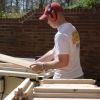I am going to need at least two more dedicated circuits for my small shop(1 for the table saw and 1 for the dc) I will probably do 110 voltage since they are both currently wired that way and I dont know how to change it, and my dc came with a wireless starter that only has a 110v plug. I was thinking about getting a few long extension cords (50-70 ft) and running them around the perimeter of the basement ceiling and back the the main box then wiring up the circuits and popping them in. Could that work? if it could what size wire should I use(both units need a 13A cord).





 Reply With Quote
Reply With Quote










